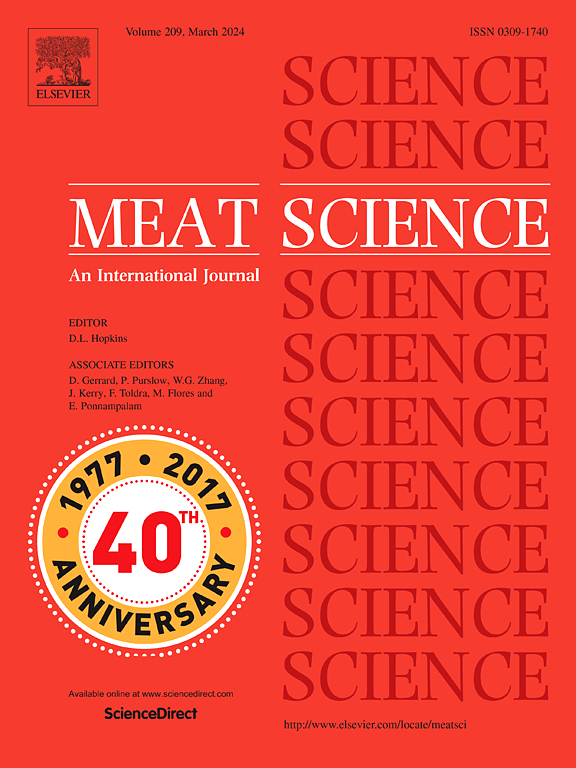不经电击屠宰牛只:与疼痛、压力和内啡肽有关的问题
IF 7.1
1区 农林科学
Q1 Agricultural and Biological Sciences
引用次数: 0
摘要
脑电图研究表明,牛在不经电击放血时会感觉到疼痛。本研究对未经电击放血的奶牛进行了比较,即在用 35 厘米长的刀放血前一小时,在放血切口部位接受局部麻醉的奶牛(卢卡因;Luro 奶牛)与未接受局部麻醉的奶牛(生理盐水:安慰剂奶牛)。对可能与疼痛或压力有关的各种生理指标进行了评估。与对照组相比,屠宰过程中心率(P <0.02)和皮质醇水平(P <0.001)的升高表明两组均存在屠宰应激。屠宰时的 GSH/GSSG 比率、血浆 PGE2、TNFα 和 NO 水平以及血细胞比容水平不受屠宰或处理的影响。在出血时,除去 15 头未丢失数据的奶牛中的两头,安慰剂奶牛从角膜反射消失到呼吸停止之间的延迟时间更长。死后,安慰剂奶牛的长腱肌(Longissimus muscle)pH值下降更快,且温度仍然较高。总体而言,结果表明该组奶牛的应激水平更高,可能是由于疼痛所致。两组奶牛出血后,血浆或大脑相关结构中的β-内啡肽含量均未增加,因此不支持应激或疼痛引起的内啡肽释放可减轻切割后疼痛感的假设。此外,根据现有的知识,血浆中的β-内啡肽并不会减轻疼痛感。因此,我们的研究和之前的研究都没有提供证据证明不经电击的屠宰至少不会对部分动物造成疼痛或其他形式的应激。本文章由计算机程序翻译,如有差异,请以英文原文为准。
Slaughter of cattle without stunning: Questions related to pain, stress and endorphins
EEG studies have suggested that cattle perceive pain when bled without stunning. The present study on bleeding without stunning, compared cows that had received a local anaesthetic on the site of the bleeding cut (Lurocaine; Luro cows) one hour before bleeding with a 35 cm knife, with cows that had not (saline: Placebo cows). Various physiological indicators potentially related to pain or stress were evaluated. Increases in heart rate (P < 0.02) and cortisol levels (P < 0.001) during slaughter, compared to control levels are indicative of slaughter stress in both groups. GSH/GSSG ratio, plasma PGE2, TNFα, and NO levels and blood haematocrit levels at slaughter were not influenced by slaughter or treatment. At bleeding, excluding two out of the 15 cows with non-missing data, Placebo cows presented a longer delay between the loss of the corneal reflex and respiratory arrest. Post-mortem, Longissimus muscle of Placebo cows had a faster pH decline and remained warmer. Overall, results suggest greater stress levels in this group, probably due to pain. Plasma or brain β-endorphin contents in relevant brain structures did not increase following bleeding in either group, thus not supporting the hypothesis that stress or pain-induced release of endorphins reduces pain perceived following the cut. Furthermore, according to existing knowledge, plasma β-endorphins do not reduce pain perceived. Thus, both our study and previous research do not provide evidence that slaughter without stunning does not cause pain or other forms of stress in at least part of the animals.
求助全文
通过发布文献求助,成功后即可免费获取论文全文。
去求助
来源期刊

Meat Science
工程技术-食品科技
CiteScore
12.60
自引率
9.90%
发文量
282
审稿时长
60 days
期刊介绍:
The aim of Meat Science is to serve as a suitable platform for the dissemination of interdisciplinary and international knowledge on all factors influencing the properties of meat. While the journal primarily focuses on the flesh of mammals, contributions related to poultry will be considered if they enhance the overall understanding of the relationship between muscle nature and meat quality post mortem. Additionally, papers on large birds (e.g., emus, ostriches) as well as wild-captured mammals and crocodiles will be welcomed.
 求助内容:
求助内容: 应助结果提醒方式:
应助结果提醒方式:


